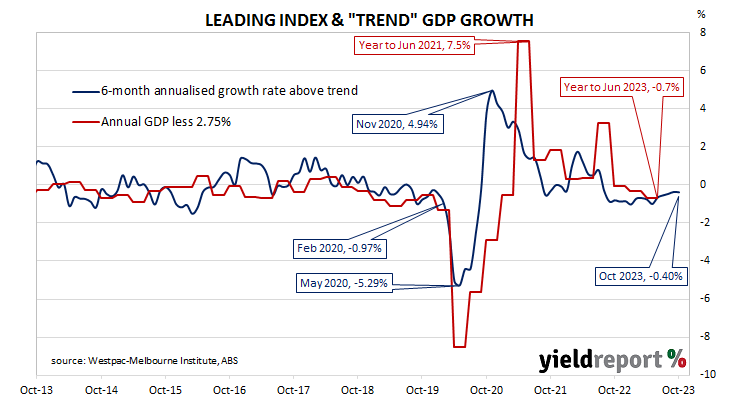Summary: Leading index growth rate down a touch in October; activity set to remain in “low-growth rut”; reading implies annual GDP growth of around 2.15%; ACGB yields barely move; rate-rise expectations firm; Westpac expects GDP growth in 1%-2% range in 2023, 2024.
Westpac and the Melbourne Institute describe their Leading Index as a composite measure which attempts to estimate the likely pace of Australian economic growth in the short-term. After reaching a peak in early 2018, the index trended lower through 2018 and 2019 before plunging to recessionary levels in the second quarter of 2020. Subsequent readings spiked towards the end of 2020 but then trended lower through 2021, 2022 before flattening out in first half of 2023.
The October reading of the six month annualised growth rate of the indicator registered -0.40%, down a touch from September’s revised figure of -0.38%.
“The Leading Index shows little change in the Australian economy’s sub-par performance,” said Westpac senior economist Matthew Hassan. “October marks the fifteenth successive sub-zero read on the Index growth rate, signalling that the activity is set to remain in the ‘low-growth rut’ that has prevailed throughout 2023 well into 2024.”
Index figures represent rates relative to “trend” GDP growth, which is generally thought to be around 2.75% per annum in Australia. The index is said to lead GDP by “three to nine months into the future” but the highest correlation between the index and actual GDP figures occurs with a three-month lead. The current reading is thus indicative of an annual GDP growth rate of around 2.15% in the next quarter.
Domestic Treasury bond yields barely moved on the day, ignoring moderate declines of US Treasury bonds yields overnight. By the close of business, the 3-year ACGB yield had slipped 1bp to 4.09% while 10-year and 20-year yields both finished unchanged at 4.46% and 4.74% respectively.
In the cash futures market, expectations regarding further rate rises firmed. At the end of the day, contracts implied the cash rate would remain close to the current rate of 4.32% and average 4.325% through December and 4.385% in February. May 2024 contracts implied a 4.415% average cash rate while August 2024 contracts implied 4.375%, 6bps more than the current rate.
“With Australia’s population currently growing at around 2.4%, our ‘trend’ GDP growth rate is well above 3% even under very conservative productivity assumptions,” Hassan added. “Both Westpac and the RBA expect actual growth to be in the 1%-2% range both this year and next, tracking well behind any reasonable estimates of trend.”


